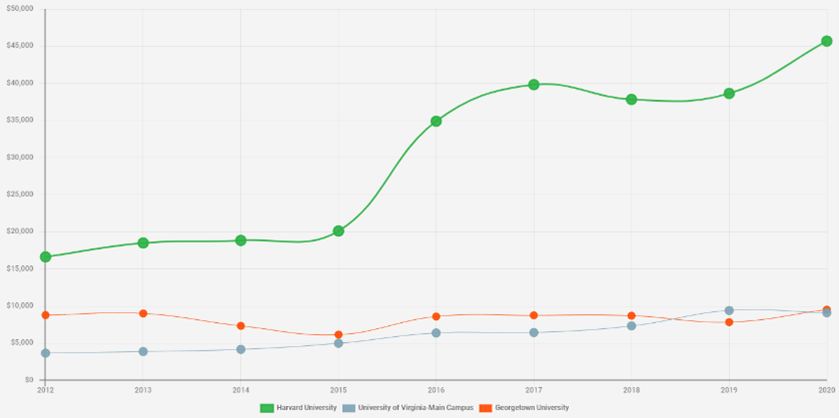The College Donor Digest
A Revenue of $52,000,000,000: Part II
April 21, 2022 | Emily Burden Rees
Effective Givers & Spenders
Colleges and universities received $52 billion in charitable donations in the last fiscal year, with alumni contributions totaling $12.2 million (23% of the total). Donors who invest so much deserve to know how their college recipients use their gifts.
Giving to higher education is complicated. Unlike giving to a local charity, where a donor may meet the director or charitable recipients, college donors encounter an administrative behemoth. According to the National Center for Education Statistics,19.4 million students were enrolled at American colleges and universities in 2021. In the same year, these institutions employed 3.1 million faculty and staff, according to IBISWorld.
Donors need more information than they might think to give effectively. The American Council of Trustees and Alumni’s (ACTA) college spending website, HowCollegesSpendMoney.com makes college and university finances more transparent by reporting metrics like per-student spending on administration, instruction, and student services, as well as enrollment, graduation, and inflation-adjusted tuition rates at over 1,600 institutions. Donors using this website can better gauge the ability of potential gift recipients to use funds effectively.

On HCSM.com, donors can examine one school at a time or compare multiple institutions. The graph above shows that Harvard University spent $35,000 per student on administrative expenses in 2016 and nearly $46,000 per student in 2020, an increase of 31% in just four years. This does not include spending on student services or instruction. Harvard students have had to bear the cost of the eruption in administrative spending, paying $9,000 more per year than their peers who graduated in 2012.
Educating college students is expensive, and universities go through millions of dollars per year. College donors should examine spending trends to determine whether the university’s financial priorities align with their values. Donors who believe that students should graduate without debt may want to look at inflation-adjusted tuition costs over the past 10 years. If they value a strong curriculum, they may search for colleges that spend comparable amounts on instructional expenses as they do on administrative expenses.
Sometimes, institutions can become distracted from funding their educational mission. In 2017, Louisiana State University spent $85 million updating its recreation center, crowned by a lazy river forming the letters “LSU.” According to the New York Times and the Chronicle of Higher Education, “it was L.S.U. students who footed the bill” whose “annual fees have tripled in inflation-adjusted dollars” since 2000.
This is not an isolated occurrence. The University of Alabama, the University of Iowa, the University of Akron, the University of Missouri, the University of Central Florida, and Texas Tech University all have new lazy rivers, indicating higher education’s shift from learning hub to premium-priced social club.
The solution to the higher education runaway spending problem is, yes, institutions with integrity, but also savvy donors who know how and where to give. Wise donors will carefully select institutions with a proven track record of responsible spending.
As ACTA President Michael Poliakoff explained in a Forbes essay, “Done right, higher education philanthropy can accomplish remarkable ends. It can limit the financial burden placed on taxpayers and families; it can fund innovative research that pushes the boundaries of human knowledge; it can maintain academic programs that are often financially neglected; and it can help raise colleges to higher standards.” Good donor-college relationships foster excellence.
Higher education is a mission worth funding well.
There are many time-saving and easy-to-use tools, including HowCollegesSpendMoney.com, that donors can employ to examine a school’s financial picture. By understanding how university funds are spent, donors can give more effectively and encourage the institutions they support to remain accountable to the students, taxpayers, and donors who make their mission possible.






